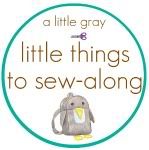Hi,
I was so thrilled when I found
Pat Bravo's site. She's got a great fabric and pattern line. As I browsed her site, I found a
free quilt pattern (Le Petite Garden) that I thought I could make fairly quickly.
Well, "fairly quickly" is a relative term when speaking about quilt making, right? The quilt was to be made as a gift. As always, I was short on time. The design seemed simple because there were no seams to match-up. No, points to connect. Just plain straight 1/4" seams. I was pretty sure I could do that successfully. I believe the beauty of the quilt can come from the fabric selection. The quilt is basically cut from 6.5" fabric strips. Although the pattern did not have any cutting layout instructions, it's straight forward to figure out because everything is based on that 6.5" strip. There are 6 different fabrics that are cut into 6.5" strips. The cotton fabric I selected is by
Riley Blake Designs, Summer Song from My Mind's Eye. I loved it because it was bright, cheery and had bold colors.
I washed and dried my fabric before I began to make my strips and I'm glad I did. I measured the fabric to get a rough idea of how many pieces I could cut from each 6.5" strip of fabric. After the washing and drying, the width ranged from 40" to 42" and it was originally 44"/45" wide. Here's my guideline for cutting out the quilt pieces based on my washed/dried size (yours may differ):
I started making the quilt on a Tuesday night. I spent about 2 hours cutting the fabric out and getting it stacked and in the right order.
On Saturday, I spent almost 6 hours sewing the quilt top together. The directions were very clear but I decided to deviate slightly in hopes of speeding up the processes. I started by sewing the 38 blocks, as directed. I chain stitched the strips to produce the block. I placed one green strip on the button and then placed the center strip on top, centering the strips.
And then fed it through my sewing machine like so...

When all the middle strips where gone, I knew it was time to stop my chain stitching (cut my thread) and take it to the ironing board and iron. My pile looked like this.
One more strip and the block is done.
The blocks end up looking like this
These blocks are used throughout the quilt, alternating between the remaining rectangles. All odd rows will use the large rectangles, (11"x 6.5") and will have 4 of these rectangles alternating between the 3-strip blocks using 3 3-strip blocks/row. For instance, all rows will begin with a cut rectangle (large or small) and then followed by the 3-strip block pictured above. The even rows will contain the 5 of the smaller (7 3/4" x 6.5") rectangles alternating with the 3-strip blocks using a total of 4 3-strip blocks. The rows are laid out as follows:
Row 1: B, F, C, G (11"x 6.5")
Row 2: G, D, B, F, C (7 3/4" x 6.5")
Row 3: F,C, H, B (11" 6.5"0
Row 4: D, G, C, H, D (73/4" x 6.5")
Row 5: G, H, F, B (11"x 6.5")
Row 6: H, F, D, G, C ( 7 3/4" x 6.5")
Row 7: C, B, C, H (11"x 6.5")
Row 8: F, C, H, D, F (7 3/4" x 6.5")
Row 9: G, F, C, D (11"x 6.5")
Row 10: B, H, E, H, G ( 7 3/4" x 6.5")
Row 11: F, G, B, C (11"x 6.5")
I stacked up all my rows and started to sew the blocks so that the block was on the right side:
I continued to take a rectangle from my sorted stack and sew a 3-strip block on the right. As I pulled a rectangle from my sorted stack, I checked the next size rectangle to see if it was a different size. If it was, that was my signal that the rectangle I had in my hand was the last one in the row and I needed to open what I had just sewn and sew that rectangle to the 3-strip block making sure the last rectangle in the row was sewn to the right of the 3-strip block.
My rows started to look like this:
When I was through with my sorted stack, I re-stacked my rows as I clipped the threads. My next pass was to completely connect each row, making sure to each rectangle sandwiched in between a 3-strip block.
In the end, this is what my finished quilt top looks like. Sorry about the poor photo.
Credo,
Lisa















































